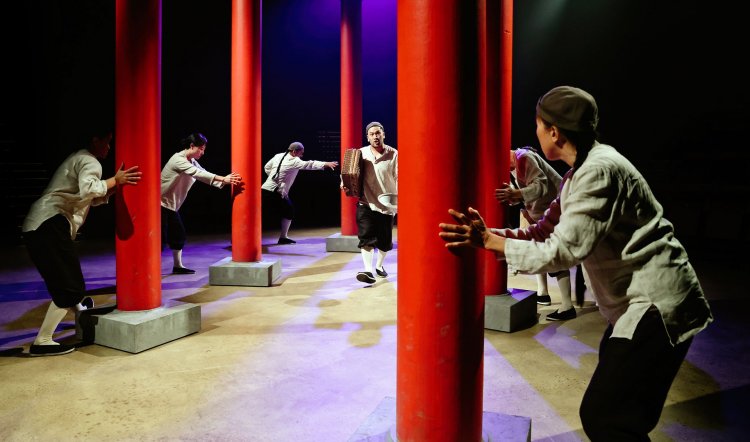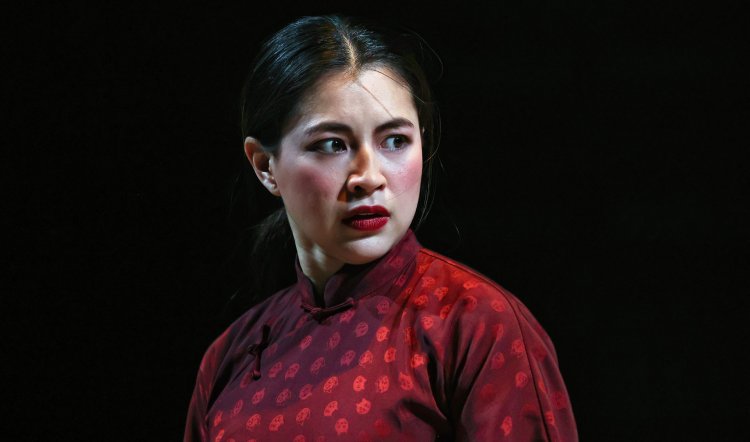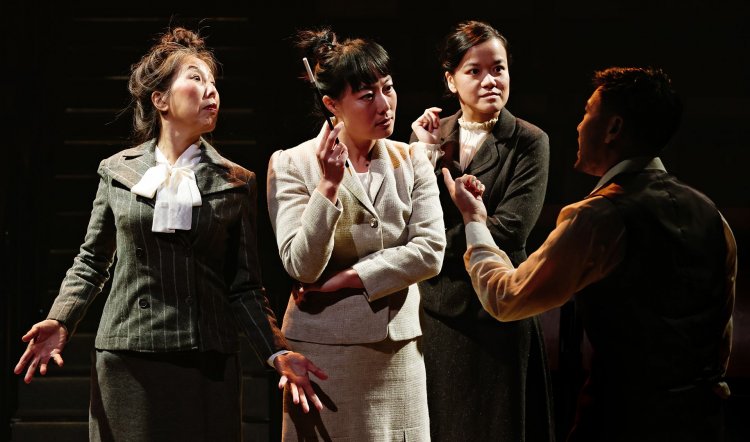
THE POISON OF POLYGAMY
THE POISON OF POLYGAMY, Sydney Theatre Company and La Boite Theatre at Wharf 1, 8 June-15 July 2-23. Photography by Prudence Upton: above - the company; below - Kimie Tsukakoshi; below again - Anna Yen, Hsin-Ju Ely, Merlynn Tong and Shan-Ree Tan
The Poison of Polygamy is a unique new experience – unless you happen to be Chinese-Australian or an unusually China-literate non-Chinese. Judging by the opening night audience at Wharf 1, it’s also a thrilling event for Chinese-Australians, however, accustomed as they are to seeing themselves in subservient or negative bit parts. As it is, Anchuli Felicia King’s stage adaptation of Australia’s first Chinese language novel is eye-opening.
First published, Dickens-style, in weekly newspaper chapters across 1909-1910, The Poison of Polygamy, by Wong Shee Ping, is a rich brew. As befits its times, there are homilies and morals, good wives and opium-addled husbands, adventure and misadventure, dreams of riches and nightmares of poverty, and everything else in between. Success is rare, failure is a given, avarice and violence are everywhere. When men leave home and set sail for the Australian goldfields, death and taxes are the only certainties.
With Wharf 1 set up in its round configuration, the audience is greeted by a bare stage. Enter The Preacher (Shan-Ree Tan) in neat dog collar and the shiny confidence of man sure of God’s approval. He sets the scene, giving ethical hints and high-minded advice while posing questions that will echo across the three hours running time.
(If three hours seems daunting, think of Nicholas Nickleby or Cloudstreet, or the movie masterpiece Ten Canoes in which a much-amused Gulpilil twinkles at the audience and warns that this is his story, he’ll tell it in his own good time and is not going be hurried by impatient Whities.)

As it is, when The Preacher makes way for a portrait of village life, it becomes apparent that life is tough in the dying years of the Qing dynasty (1636–1912). In a neat move, Shan-Ree Tan also plays the unkindly nicknamed Sleep Sick – a good husband until he became an opium addict, who constantly tries the patience of his loyal wife Ma (Merlynn Tong). At their wits end and with their money up in smoke, Sleep Sick, encouraged or hindered by village men (Ray Chong Nee, Silvan Rus and Gareth Yuen), sets out for the promise of Melbourne.
Aside from wooden chairs and a rickety bamboo bed, the only “scenery” is six tall lacquer red columns, silently wheeled off and on and manoeuvred by the actors. One column becomes the rising and falling prow of the ship that carries the men on which Sleep Sick is incessantly seasick into his gold-panning pan (designer James Lew).
The hapless miners disembark in Robe, South Australia to avoid Victoria’s anti-Chinese tax. They discover they’ll have to walk to the gold fields – not Melbourne – a trek of 400 kilometres. Along the way they pass the desiccated corpses of those who didn’t make it. When they do, very little improves for the men.
On the mainly empty sand-coloured stage, the images of these stories are conjured in the mind by the novel’s lavish language, which King fully uses. The text is often declamatory and political in Brechtian fashion when not delivering broad laughs that leaven the narrative. And it pays to heed the warning from The Preacher that we will go back and forth in time and be in the company of ghosts.

As well as the vivid if ironic use of red – the colour of prosperity and celebration – the 1800s miners are clad in long, loose white shirts. White being the colour of death and mourning, while their long pigtails signify the favoured caricature of the Chinese (viz The Bulletin and “Australia for the White Man”).
Director Courtney Stewart neither crowds the narrative nor muddles the action as she manages the tricky feat of serving the play, the actors and the encircling audience without making it seem contrived. She also draws out the small portraits within the sweep of the bigger picture as Hsin-Ju Ely (Mrs Lui/Mrs Ching) and Anna Yen as Villager 3, Sleep Sick's mother and Ma’s mother and Mrs Lin bring to life the women and life left behind with clarity, contrast and conviction.
The second half largely centres on the previously signalled “wanton concubinary”, which actually translates as a small girl sold to a family as a bonded maid, reaching adulthood and being further sold on as a concubine. In the role of the unfortunate Tsiu Hei, Kimie Tsukakoshi grows from coy teenager to avenging angel in the most fully-realised character on stage. She’s terrific.
The Poison of Polygamy is hugely entertaining, revelatory and thought-provoking. Ignore the trigger warnings (yawn) and take the family. Eyes, hearts and minds will be flung open as never before. Recommended without reservation.



-c444x300.jpeg)